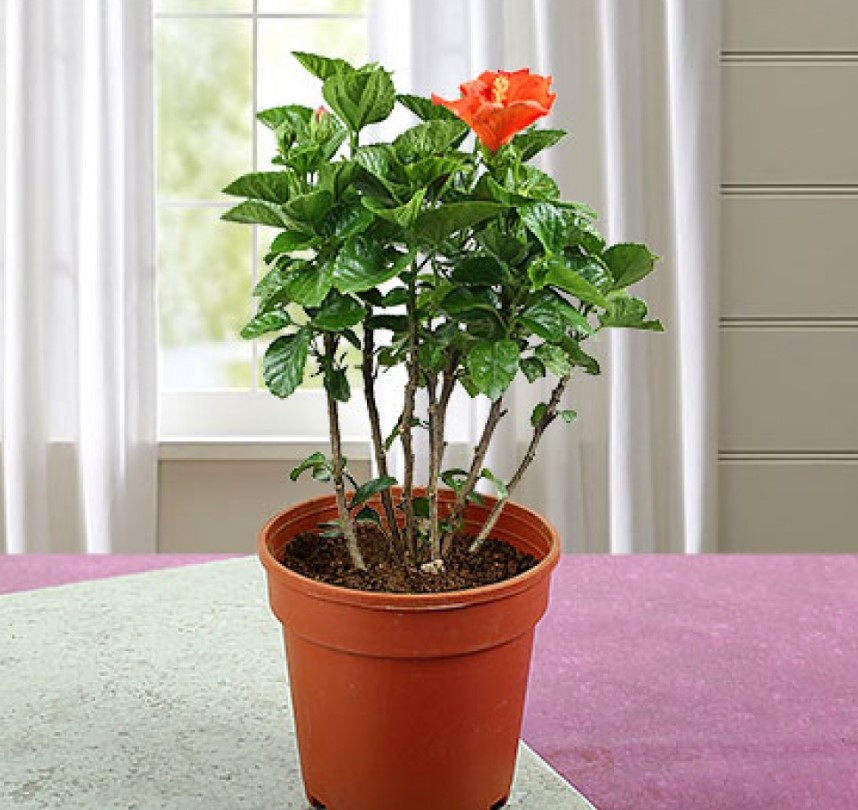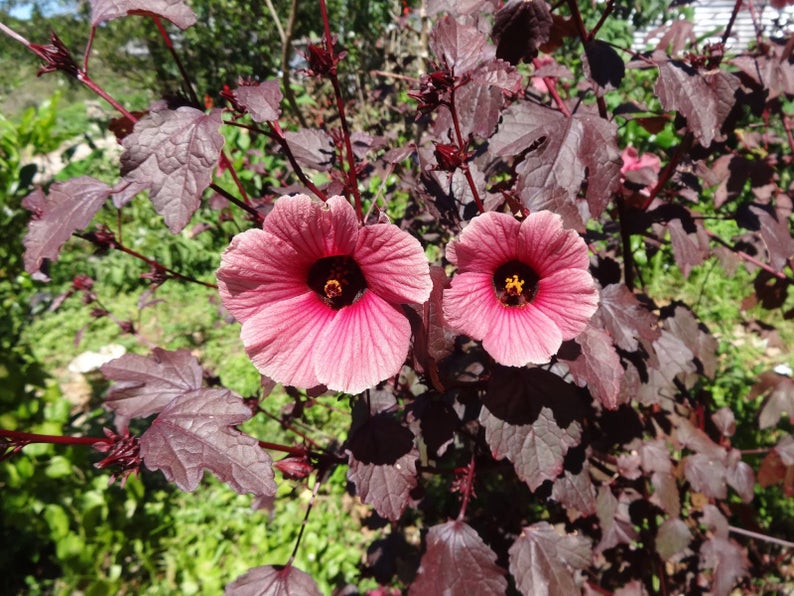Hibiscus plants are tropical shrubs mostly kept for their beautiful large flowers. Hibiscus requires plenty of sun and water, and the soil needs to be rich in organic matter. Since they thrive in the warm climate, they require great care to do well outside the tropics. Most people outside the tropics grow hibiscus in pots to move the plant to different locations depending on the weather.
What Type of Potting Mixture is Best for Hibiscus?
The planter for hibiscus has to have plenty of holes for drainage to prevent the roots from rotting. The container size mostly depends on the size of the hibiscus plant, but it can generally be as small as ten inches(25cm) in diameter for one plant. Clay pots are preferred as they are porous, therefore preventing overheating of the roots during hot weather. Avoid black or dark-colored plastic pots.
The best soil for hibiscus is airy, moist but perfectly drained and slightly acidic with a pH of 6.5-6.8. The potting mix recipe is two parts peat moss for acidity and to hold moisture and nutrients, one part vermiculite or perlite and two parts loam soil to provide drainage. Hibiscus plants will need plenty of water, especially during hot weather, and may require daily watering.
What is the Best Fertilizer for Hibiscus Plants
Proper nutrition with the help of fertilizers keeps the hibiscus plant blooming all year beautifully. You can use either slow-release or water-soluble fertilizer. Liquid fertilizer should be prepared in half-strength to prevent over-fertilizing and is preferred because it quickly disperses in the soil.

The best hibiscus fertilizer should contain medium nitrogen, low phosphorous, and high potassium. Every part of the hibiscus plant relies on potassium for proper functioning and the photosynthesis it supports. At the same time, nitrogen supports the plant’s metabolism. Insufficient nitrogen in plants causes stunted growth. However, excess nitrogen burns the leaves. Low phosphorous is vital for blooming and root health.
A good fertilizer should also contain trace amounts of minor nutrients such as iron, magnesium, and copper. You can also use organic fertilizers to supplement chemical fertilizers with nutrients and improve soil quality. The idea is to put the organic matter that contains nutrients suitable for hibiscus. These include:
- Organic mulch is for preserving soil moisture and suffocating weed growth, which decomposes to provide nutrients further. You can use oak leaves, pine needles, bark chips, or shredded bark.
- Epsom salt provides magnesium and sulfur, micro-nutrients that help plants absorb nitrogen and phosphorus and produce chlorophyll. It promotes bushier plants and better blooms.
- Banana peels provide potassium and low nitrogen levels because they are known to be rich in potassium.
How Often Should I Fertilize My Hibiscus?
The key is to fertilize lightly and often, especially those grown in containers. It is best to feed your hibiscus once a week when the plants are growing, hold off during the coldest months in your region, and then resume when the weather starts to warm up. Use more fertilizer during the scorching season with frequent watering.
Similarly, apply the fertilizer in the morning when temperatures are cool to prevent it from evaporating and not reaching the roots. You do not also need to use fertilizer during winter.
Use slow-release fertilizer four times a year. How often you use liquid fertilizer depends on brand and formulation.
How Do I Prune Hibiscus?
Pruning is trimming branches to stimulate budding and also maintain the desired shape. Pruning hibiscus is not necessary, but sometimes it is appropriate. Here are some signs that your hibiscus needs pruning:
- Presence of dead branches and leaves.
- Production of fewer flowers.
- When the plant grows tall and weak.
- Signs of disease such as spotted leaves and the presence of pests.
Do this in the early spring to line up with the natural growth of the plant. Avoid pruning when it is cold, as this will stunt the plant’s growth.
Most hibiscus relish being cut back about one-third of the stem all over. There are a few exceptions that do better when left uncut. For very woody stems, cut back halfway or more to induce new, healthy wood.
There are several pruning techniques depending on what you want to achieve and what type of hibiscus plant you have:
- Pinching is cutting off the topmost node of young plants for a fuller bush.
- Selective pruning is cutting off selected branches and stems for the desired shape.
- Full prune is cutting to leave 2-3 nodes on all branches for a more uniform look.
- Hard prune is for old and neglected bushes, which is cut very low but not lower than one foot from the ground level.
Steps for Pruning
- Sharpen and sterilize your pruning shears to minimize damaging the plant and spreading diseases through the open cut.
- Observe the growth pattern and direction of your leaves and branches, where you cut will either correct or worsen the problem. Also, keep in mind that the new growth will happen just below the cut you make. From this, decide what type of pruning you will do.
- Cut the branches down by approximately one-third. And a quarter-inch above a node( where the leaf means the stem) at an upwards 45-degree angle. More branches will grow from here in several directions. Do light pruning on slow-growing plants. Adjust how much you cut off according to your plant’s state, but no more than two-thirds of any branch.
- Remove any branches that are weak, diseased, dead, or leggy. Remove branches growing towards the center of the plant.
- Fertilize your plant with a fertilizer rich in nitrogen and potassium to promote budding.
Make sure to remove all trimmings from the plant after cutting to ward off diseases and pests.
Do You Deadhead Hibiscus?
Deadheading is the removal of faded flowers for the aesthetic purposes of the plant and prevents reseeding. Removing old fading flowers before seeds form will help the plant bloom again since the plant’s energy diverts from seed production to bud growth.
On the other hand, deadheading hibiscus is not a necessary process of care as they are ‘self-cleaning’ plants, dropping off on their own after a day or two, and replaced with a new bud. Deadheading also prevents the blooming of delayed flowers later in the season and is a waste of time for hibiscus.
Should I Cut Back my Potted Hibiscus?
Cutting back is for plants that grow too tall and weak to support themselves. To allow the plant to grow sturdier, you cut a third of the branches and repeat it after a month. Cutting back will stimulate budding of more stems. You can cut back a potted tropical hibiscus to maintain a bushier look and support more blooming. However, severe pruning will delay the growth of their first blooms by two to four months.

Why is My Hibiscus Plant Not Blooming?
The flowering of hibiscus varies due to plant variety and climate. Ideally, hibiscus blooms after eight to twelve months, but there are several reasons why yours looks healthy but does not produce flowers such as; nutritional deficiencies and environmental conditions.
Sunlight and temperature
Hibiscus is a tropical plant that loves sunshine and warm weather. Cooler temperatures and low sunlight can slow down blooming. Make sure to move your potted hibiscus under the full sun for blooming. Too much sun is also not good for hibiscus; therefore, it is best to shade the plant during the extreme afternoon heat.
If you live outside the tropics, over-wintering your hibiscus in a cold dark room can cause delayed growth and bloom in spring and summer. It is imperative to allow the plant to receive regular sunlight even during winter.
Water
Hibiscus is a water-loving plant mainly in the summer, insufficient water reduces blooming. For that reason, you may have to water the plant daily, especially during hot and dry weather. On the other hand, do not over-water your hibiscus. The soil has to be moist but not soaking wet. It is crucial to maintain proper drainage. You can also use compost mulch to help retain soil moisture and coolness.
Fertilizer
Hibiscus needs plenty of nutrients to bloom all year long, especially potted ones. The plant could be starving from the right nutrients such as potassium and phosphorous, which help in blooming. Use a “bloom booster” fertilizer or add some organic fertilizer like bone meal or crushed eggshells to the soil to add phosphorous. Do not use too much chemical phosphorous fertilizer as it reduces micro-nutrients by bonding with them in the soil.
If you have re-potted your plant recently, hibiscus responds to excess nitrogen fertilizer by growing large green leaves and reduced flowers. Stopping fertilization will help, but don’t expect flowers before winter.
Container size
If the pot is narrow and deep, the plant will focus all its energy on growing longer roots than the growth of parts above the ground, resulting in fewer flowers.
Pruning
Pruning hibiscus too often and late in the spring will cause too much stress for the plant hence, affecting the budding process.
Soil
Hibiscus is a heavy feeder and needs fertile soil. Other than using fertilizer, organic matter like compost mulch helps improve the soil quality. The soil also needs to be acidic, since alkaline soil may affect growth and budding.
Pests and disease
Hibiscus is a delicate plant that is prone to infestation by pests and disease. Regularly inspect the plant for pests and damage such as spotted leaves and sticky substance on stems. Remove minor pests by spraying the plant with water, but for recurring infestations, they can apply pesticides and fungicide for mold.
How Do I Get More Flowers on My Hibiscus?
Hibiscus blooms are governed by weather conditions and produce most flowers during autumn and summer. Though the hibiscus flower only lasts a day, a new one is replaced after, meaning it guarantees fresh flowers for months with proper care. Here are some tips you can use to get more hibiscus flowers:
- Re-potting. Re-pot the plant annually to a larger pot to encourage new growth and keep the roots healthy. Trim and untangle the tangled roots to improve absorption. Remember also to use fresh soil every time you replant.
- Pruning. Prune or pinching the tips of stems in the early spring promotes budding. Pruning makes the bush fuller, meaning, the more the branches, the more the flowers.
- Move the plant under the full sun for around six to eight hours a day. Shade the plant from extreme sun.
- Add more water when it gets warmer, and during its growing stages, never allow the plant to dry out. Add some mulch at the base to keep the moisture in the soil.
- Apply fertilizer with low phosphorous during the flowering stage every two weeks. Use liquid fertilizer together with the slow-release fertilizer for extra blooming.
- Pests and disease. Regularly examine the plants for pests and disease, and control them using organic sprays such as neem spray.
How Much Sunlight Does Hibiscus Need?
The rule of thumb is hibiscus requires six to eight hours of full sun per day to bloom for better blooming. The more light a hibiscus gets, the more it will thrive, up to a point. Meaning, a little shade in the afternoon is beneficial during hot weather. You can use artificial light if there is no sunlight, but it’s not the most sufficient.
Check this too: How to Care for a Calandiva Plant
Keeping your hibiscus healthy and blooming is easy when you provide what it needs –the right fertilizer, adequate water, fertile soil, warm temperatures, and plenty of light in proper proportions.
